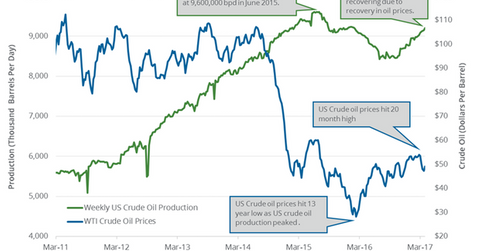Why US Crude Oil Output Hit a High from January 2016
US crude oil output is at the highest level since January 25, 2016. The rise in crude oil output is the biggest bearish driver for crude oil prices in 2017.
Nov. 20 2020, Updated 1:31 p.m. ET

US crude oil output 
The EIA (U.S. Energy Information Administration) reported that US crude oil output rose by 52,000 bpd (barrels per day) to 9,199,000 bpd from March 24–31, 2017. Output rose 0.6% week-over-week and 2% year-over-year. US crude oil output is at the highest level since January 25, 2016. The rise in US crude oil output is the biggest bearish driver for crude oil (PXI) (DIG) (UCO) (USL) prices in 2017.
Lower crude oil prices have a negative impact on oil and gas producers’ earnings like SM Energy (SM), Sanchez Energy (SN), Hess (HES), and Devon Energy (DVN). For more on crude oil prices, read Part 1 of this series. For more on monthly crude oil production, read Monthly US Crude Oil Production Hit May 2016 High.
Peaks and lows  
US crude oil output peaked at 9,600,000 bpd in June 2015. In contrast, it hit a low of 8,428,000 bpd for the week ending July 1, 2016—the lowest level since June 2014. Since then, US crude oil output has risen ~9.2%.
Lower crude oil prices, higher break-even costs, and higher production costs for US shale oil producers compared to other oil producers led to the fall in US crude oil output in 2016.
However, the recovery in crude oil prices since early 2016 led to the rise in US crude oil drilling activity and US crude oil output in late 2016 and early 2017.
US crude oil production estimates  
The EIA estimates that US crude oil output will average 9,210,000 bpd and 9,730,000 bpd in 2017 and 2018, respectively. US crude oil output averaged 8,880,000 bpd in 2016.
US output could rise in 2017 due to the following factors:
- technological advances causing a rise in US drilling activity even at lower crude oil prices
- higher crude oil prices in 2017—compared to 2016
- implementation of President Trump’s proposed energy policies
The rise in output could pressure US crude oil (XLE) (XOP) prices. The US might be the main producer to offset a fall in the crude oil supply from major oil producers’ output cut deal. If OPEC doesn’t extend major oil producers’ output cut deal, it could pressure crude oil prices. Read Russia’s Central Bank: Crude Oil Prices Could Hit $40 per Barrel for more on crude oil price forecasts.
In the next part of this series, we’ll take a look at US crude oil refinery demand and crude oil imports.
